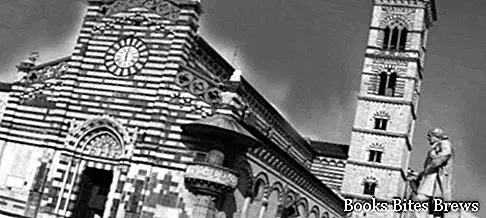What to see in Prato, a one-day itinerary including the main monuments and places of interest, including the Duomo, the Emperor's Castle, the Basilica of Santa Maria delle Carceri and the Textile Museum.
Tourist information
Since prehistoric times the territory of Prato was the seat of human allocations, the numerous artifacts found in the Galceti area, a locality located on the southern slopes of Monte Ferrato, north-west of the city, testify to this.
Archaeological excavations in the Gonfienti area, east of Prato, have brought to light an Etruscan city of considerable size, demonstrating the presence of the Etruscan people in the area, however already ascertained by other important archaeological finds.
When the Romans arrived, the land where Prato stands today was destined for centuriation, that is to say organized according to a precise pattern of roads, canals and agricultural plots to be assigned to new colonists, generally veteran soldiers, while the existence of an urban settlement of this era.
Subsequently, the Lombards settled in the Prato area, especially in the Val di Bisenzio and in the Montemurlo area, but it is necessary to wait for the ninth century to get the first news of the town of Prato.
It was in fact around the early eleventh century that the urban center of Prato was formed, through the merger of two inhabited areas, that of Borgo al Cornio, located near the Pieve di Santo Stefano, the current Cathedral, and the one next to the residence of the Alberti Counts, above the ruins of which the Castle of the Emperor was built by Frederick II.
Prato was established as a free municipality in the twelfth century, between the twelfth and thirteenth centuries the processing of wool and the manufacture of fabrics began, also thanks to the presence of the Bisenzio river, which favored the creation of a system of channels called gore, dug on purpose to receive its waters and useful for providing energy to fullers, as well as for washing clothes.
Textile art established itself and had a great development in the fourteenth century, with the creation of the guilds of the arts and commercial exchanges with other European countries.
The archive of letters, registers and other objects that belonged to Francesco Datini, the famous merchant of Prato, are very interesting proof of this.
Meanwhile, nearby Florence, which had always had conquest aims towards Prato, had full control in 1351.
Prato was sold by Queen Giovanna of Naples to Florence and followed its fate in the following centuries, both under the Medici dynasty and with the Florentine Republic, and precisely as a consequence of an agreement made by the Medici with the army of the Holy League, a The alliance made between Pope Julius II and the Spaniards, as they had been driven out of Florence and wanted to return there, on August 29, 1512, the Spanish soldiers besieged the city of Prato and made a tremendous devastation, called the Sack of Prato.
Recommended readings- Artimino (Tuscany): what to see
- San Galgano (Tuscany): what to see
- Poggibonsi (Tuscany): what to see
- Castiglione di Garfagnana (Tuscany): what to see
- Tuscany: Sunday day trips
Under the Medici family were built villas, noble palaces and the Church of Santa Maria delle Carceri, built on a project by the architect Giuliano da Sangallo.
The seventeenth century represented a period of economic decline for Prato, which ended at the beginning of the eighteenth century, with the arrival of the Dukes of Lorraine, who stimulated the cultural and economic development of the city, which was significantly affirmed in the following centuries.
What see
The Cathedral of Prato, dedicated to Santo Stefano, was built in the Romanesque style in the twelfth and thirteenth centuries, with the expansion of the fourteenth century which led to the addition of the Gothic cruise.
Inside there are frescoes by Filippo Lippi, considered among the most significant pictorial cycles of the early Renaissance and, in the chapel of the Sacred Cingolo, frescoed by Agnolo Gaddi, the Sacra Cintola is preserved, the belt that, according to ancient traditions, the Virgin Mary he donated to St. Thomas when he was hired.
This precious relic, very important in the religious and civil history of Prato, is shown to the faithful 5 times a year (8 September, Christmas, Easter, 1 May, 15 August), from the Pulpit of Donatello, built for this purpose on the corner right of the facade of the Cathedral.
In the Museum of the Opera del Duomo, housed in the Bishop's Palace and dating back to medieval times, remarkable works are preserved.
In the center of the Piazza del Comune there is a copy of the Fontana del Bacchino, by Fernando Tacca, whose original is located in the atrium of the Town Hall.
Palazzo Pretorio overlooks the square, dating back to the thirteenth and fourteenth centuries, which houses the municipal gallery inside.
The Basilica of Santa Maria delle Carceri, with a Greek cross, is a masterpiece of Renaissance architecture created on a project by the architect Giuliano da Sangallo.
The Emperor's Castle is an imposing square-shaped building, erected at the behest of Frederick II between 1237 and 1248.
The churches of San Domenico, San Francesco and Sant'Agostino also deserve to be visited.
The Textile Museum is located in the restored rooms of the former Campolmi cemetery, within the medieval city walls.
The Luigi Pecci Museum of Contemporary Art, located in the south-east part of the city, houses collections of international artists.




